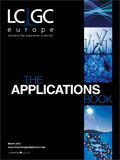Using Longer Aeris PEPTIDE Core-Shell HPLC/UHPLC Columns for Improved Peptide Mapping
Phenomenex Application Note
Michael McGinley, Deborah Jarrett and Jeff Layne, Phenomenex, Torrance, California, USA.
Introduction
A new 3.6 µm 100 Å HPLC/UHPLC column (Aeris PEPTIDE) has been introduced which is specifically designed to improve separations of peptide and peptide mapping applications. The Aeris PEPTIDE XB-C18 column was developed to complement Aeris WIDEPORE XB-C18 coreshell columns for protein characterization. When one looks at peptide mapping applications, performance requirements are significantly different to intact protein separations, as increased retention and selectivity are required to separate the large number of peptides generated in peptide mapping applications. Because increased resolution is a higher priority versus speed, a larger particle (3.6 µm) core-shell particle was developed which allowed the use of longer columns at lower back pressures. In this application the increased resolution that the longer Aeris PEPTIDE 3.6µm XB-C18 provides will be demonstrated.
Materials and Methods
All chemicals, standards and antibodies were obtained from Sigma Chemical (St. Louis, Missouri, USA). Solvents were purchased from EMD (San Diego, California, USA). Coreshell Aeris PEPTIDE 3.6 µm XB-C18 columns (150 × 4.6mm and 250 × 4.6mm) were obtained from Phenomenex (Torrance, California, USA). Bovine serum albumin (BSA) was digested with trypsin and analysed on an Agilent 1200 HPLC system with autosampler, column oven, solvent degasser and UV detector set at 214 nm. Data was collected using Chemstation software (Agilent, Santa Clara, California, USA). Mobile phases used were 0.1% TFA in water (A) and 0.1% TFA in acetonitrile and a gradient from 3–65 % (B) in 15 min was used at 1.2 mL/min. Column was maintained at 40 °C.

Figure 1
Results and Discussion
Aeris PEPTIDE 3.6 µm XB-C18 core-shell particles demonstrate similar or better performances as sub-2 µm fully-porous columns at a fraction of the back pressure, allowing the use of longer columns at back pressures compatible with existing HPLC systems. The 3.6 µm coreshell media is of particular value for peptide map applications where the increased resolution of longer columns is desired (for high-speed UHPLC applications the Aeris PEPTIDE 1.7 µm XB-C18 can be used instead). An example of this utility is demonstrated in Figure 1 where 150 × 4.6 mm and 250 × 4.6 mm Aeris PEPTIDE 3.6 µm XB-C18 columns were compared for a peptide map of BSA. The 150 × 4.6 mm column provides excellent separation of the peptide mixture at a low column back pressure (140 bar at 1.2 mL/min) so that a longer column could be used to achieve additional resolution if required. When the 250 ×4.6 mm Aeris PEPTIDE 3.6 µm XB-C18 column was used for the separation, additional peptides were resolved while still at a back pressure amenable to using standard HPLC systems (200 bar at 1.2 mL/min). These results demonstrate the performance advantage and utility of the Aeris PEPTIDE 3.6 µm XB-C18 media for highly complex peptide mapping mixtures, where one can utilize different column lengths to optimize resolution and separation time based on the needs of a specific application.
Phenomenex Inc.
411 Madrid Ave., Torrance, California, USA
tel: +1 310 212 055 fax: +1 310 212 7768
Website: www.phenomenex.com

Separating Impurities from Oligonucleotides Using Supercritical Fluid Chromatography
February 21st 2025Supercritical fluid chromatography (SFC) has been optimized for the analysis of 5-, 10-, 15-, and 18-mer oligonucleotides (ONs) and evaluated for its effectiveness in separating impurities from ONs.

.png&w=3840&q=75)

.png&w=3840&q=75)



.png&w=3840&q=75)



.png&w=3840&q=75)


















